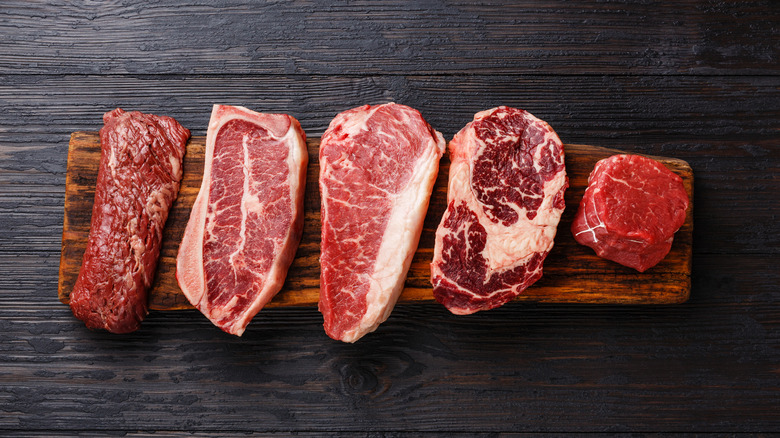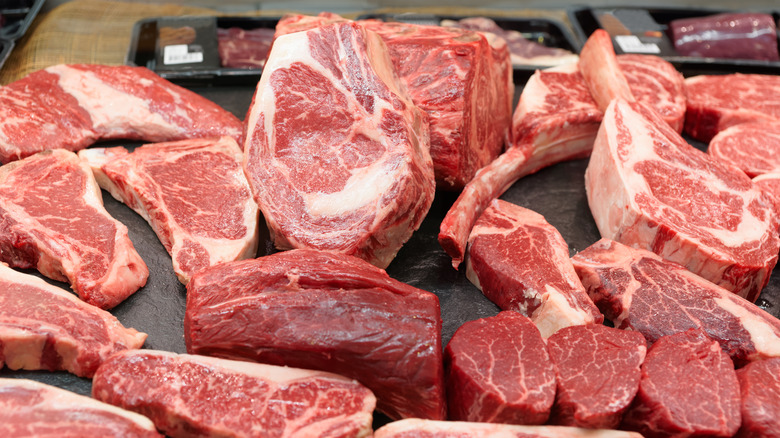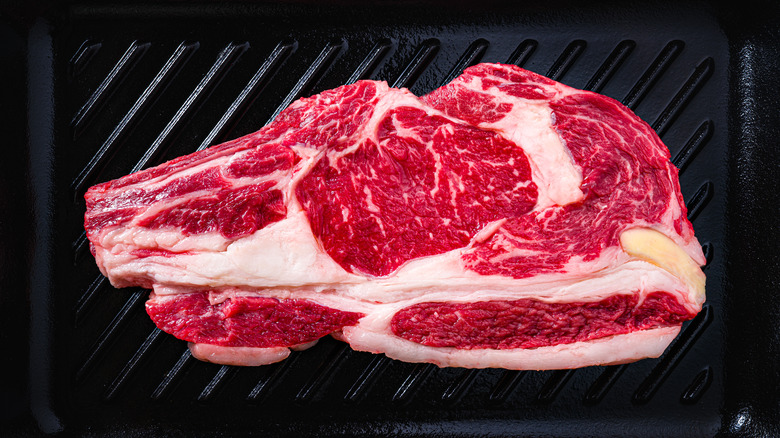How To Tell The Difference Between Tough And Tender Cuts Of Meat
Turning a tough cut of meat into a crave-able meal is one of the biggest challenges a cook can face. You never want to find yourself struggling to cut through a piece of meat and then have your hard work met with a mouthful of dry, chewy muscle. And yet, tough cuts like beef shank and brisket have provided humanity with some of its most delicious culinary creations. If you understand the piece of meat you're working with and how to treat it, you can make truly spectacular things.
On the other end of the spectrum, there are exceptionally tender cuts of meat, which you might assume are easier to work with. This can be true, but again, technique is everything. Choose the wrong cooking method; even the most prized tender ribeye can be ruined. The key to meat mastery is understanding which cuts are tough and which are tender then planning your meal accordingly.
Fortunately, there's a pretty simple rule that can help you determine whether a particular piece of meat needs the tough or tender approach. It's about knowing what part of the body each cut comes from. The most tender meat is found in the middle of an animal's back; the further you get from the spine, the tougher the meat will be. By learning a few basic terms and looking for visual cues in each cut, you can quickly determine what the muscle in question was used for and how tough or tender it will be.
It's all about what the muscles do
Different cuts of meat correspond to different muscles on an animal's body. The toughness of any given cut is determined by how much work that muscle has to do throughout the animal's life. Consider a cow, for example. The most tender cut of beef is the aptly named tenderloin, which comes from the cow's back, where the muscles move very little. On the other hand, beef cheeks are quite tough because cows spend so much time chewing cud.
There are some key terms that can help you determine which muscles correspond to which cuts of meat. When butchers break down a carcass, they begin by dividing it into large cuts called primals. A cow has eight primals: the rib, chuck or shoulder region; loin or the lower back; round, which is the rump; brisket or chest; shank or legs; plate or the upper belly; and the flank or lower belly. A pig only has four primals: leg, loin, shoulder, and belly.
As a general rule, the tenderest cuts come from the animal's loin, so keep an eye out for that word when you're shopping. Tenderloin, sirloin, and top loin are prime examples of tender cuts. Tougher cuts can be identified by references to the animal's legs and shoulders, such as shank, hocks, chuck, round, and butt. Familiarizing yourself with each cut takes time, but you can use your eyes to help you learn the differences.
Visually identifying tough and tender cuts
Every cut of meat displays some visual cues that can help you determine what that muscle did during the animal's life and whether it will be tough or tender as a result. First, look for the amount of fat in the cut and, most importantly, where it is located. Small streaks of fat within the muscle are known as marbling and enhance both the tenderness and flavor of meat. On the other hand, strips of thick fat between the muscles and around the edges of the meat can become rubbery when cooked.
Another thing to look for is the size of the muscle fibers in meat. Tough cuts from hardworking muscles generally have thick bundles of fiber, like the cross-section of a cable. Tender cuts from the back muscles have extremely thin muscle fibers you can barely see.
Both tender and tough cuts can be made into delicious meals as long as you use the proper cooking method. Tender cuts like filet mignon and ribeye steaks benefit from dry-heat cooking methods like grilling, broiling, and pan-frying. For tough cuts, there are a few things you can do to turn them tender. Slow cooker recipes are designed for tough cuts, and marinades actually absorb into the tough cuts better than tender ones, enhancing both texture and flavor. Lastly, when it's time to serve a tough-cut dish, cut the meat against the grain to make each bite as tender as possible.


